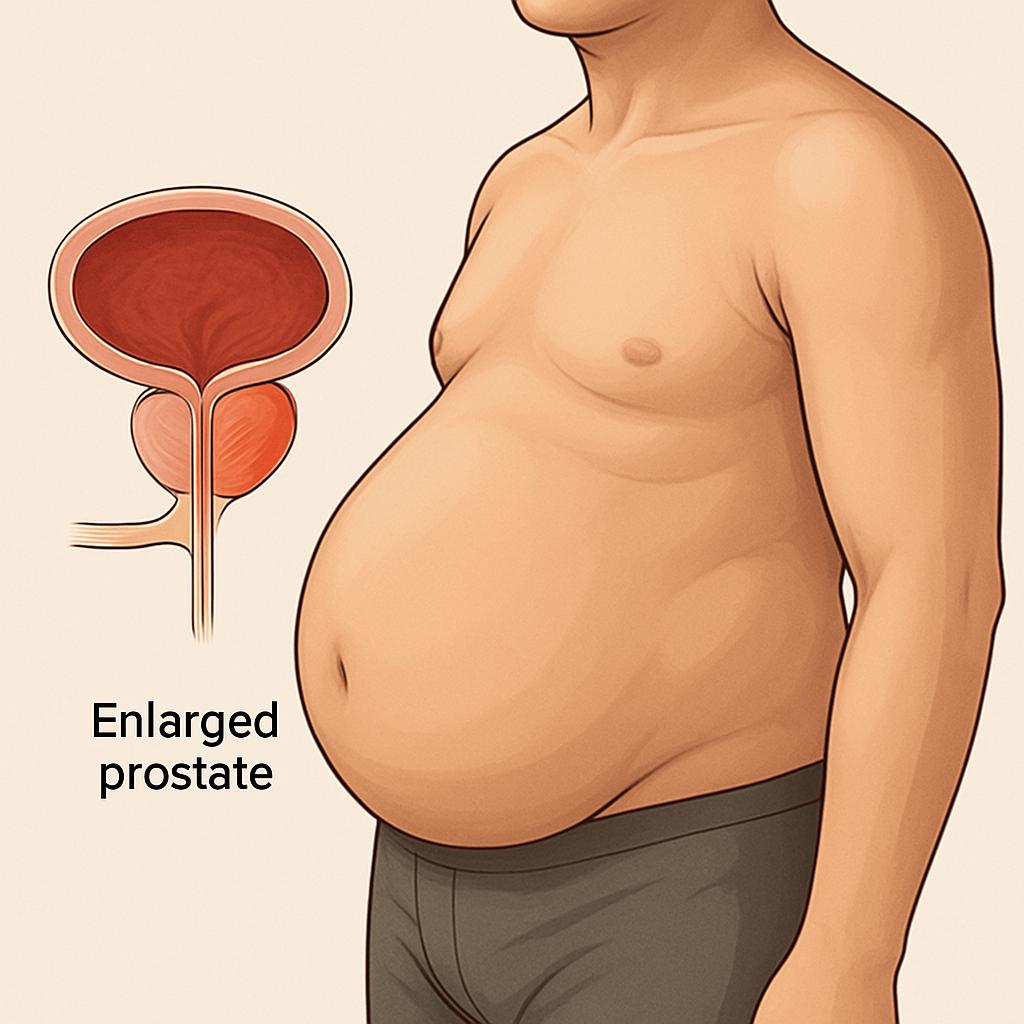Male urinary retention is a condition where a man is unable to empty his bladder fully or, in severe cases, at all. It can happen suddenly (acute) or develop gradually over time (chronic). This condition is more common in older men and can lead to serious complications if not treated promptly. Understanding the causes, symptoms, and treatment options is crucial for managing this condition effectively.
What Causes Male Urinary Retention? Common Triggers and Risk Factors
Urinary retention in men can be caused by a variety of factors. The most common causes include:
- Benign Prostatic Hyperplasia (BPH): BPH is a non-cancerous enlargement of the prostate gland, which can block the flow of urine through the urethra. This is the most common cause of urinary retention in older men.
- Obstructions: Physical blockages in the urinary tract, such as bladder stones, urethral strictures (narrowing of the urethra), or an enlarged prostate, can prevent urine from being expelled.
- Infections: Infections like prostatitis (inflammation of the prostate) or urinary tract infections (UTIs) can cause swelling and block the flow of urine.
- Neurological Disorders: Conditions that affect the nervous system, such as multiple sclerosis, Parkinson’s disease, or spinal cord injuries, can interfere with the signals between the brain and the bladder, leading to retention.
- Medications: Certain medications, particularly those that affect the nervous system, like antihistamines, antidepressants, and anticholinergics, can cause urinary retention as a side effect.
Recognising Male Urinary Retention Symptoms: Acute vs. Chronic
Acute Urinary Retention:
- This is a sudden and severe inability to urinate.
- Symptoms include severe abdominal pain, a bloated lower abdomen, and an urgent need to urinate without success.
- Acute urinary retention is a medical emergency and requires immediate treatment.
Chronic Urinary Retention:
- This condition develops slowly over time and may not cause obvious symptoms initially.
- Symptoms can include a weak urine stream, difficulty starting urination, frequent urination in small amounts, and a constant feeling that the bladder is not completely empty.
- Chronic retention can lead to bladder damage and other complications if left untreated.
Diagnosing male urinary retention: What Tests and Exams Are Involved?
Diagnosing urinary retention involves several steps:
- Medical History and Physical Examination: The doctor will review your medical history and conduct a physical exam, focusing on the abdomen and genitals to check for any signs of an enlarged bladder or other abnormalities.
- Bladder Ultrasound: This test measures the amount of urine left in the bladder after urination (post-void residual volume). A high volume suggests urinary retention.
- Catheterisation: Inserting a catheter into the bladder can help diagnose and immediately relieve acute retention by draining the urine.
- Urodynamic Tests: These tests assess how well the bladder and urethra store and release urine, helping to identify any functional issues.
Treatment Options for Male Urinary Retention: Medications, Procedures, and Lifestyle Changes
Treatment depends on whether the retention is acute or chronic and what’s causing it.
Acute Urinary Retention:
- Immediate catheterisation: The first step in treating acute urinary retention is to relieve the bladder by inserting a catheter. This helps to immediately drain the urine and alleviate the severe pain and pressure.
- Addressing the Underlying Cause: If the retention is caused by an infection, medications to treat the infection are necessary. If it’s due to medication side effects, stopping or changing the medication might be required.
Chronic Urinary Retention:
- Medications: If BPH is the cause, medications like alpha-blockers (e.g., tamsulosin) can help relax the muscles in the prostate and bladder neck, making it easier to urinate. 5-alpha reductase inhibitors (e.g., finasteride) can help shrink the prostate over time.
- Intermittent Self-Catheterisation: For some men with chronic retention, regularly inserting a catheter themselves to empty the bladder may be necessary. This can help prevent bladder damage and reduce the risk of infections.
Surgical Options for Male Urinary Retention: Exploring the Different Procedures
In cases where medications are not effective or if urinary retention is severe, surgery may be necessary to either remove part of the prostate or correct structural problems in the urinary tract. There are several surgical options available, each tailored to the specific needs of the patient. Here are some of the most common procedures:
- Transurethral Resection of the Prostate (TURP): TURP is one of the most common surgical treatments for BPH. During this procedure, a surgeon removes part of the prostate gland through the urethra using a resectoscope. This reduces the pressure on the urethra, allowing urine to flow more freely.
- UroLift: The UroLift system involves inserting small implants that hold the enlarged prostate tissue away from the urethra, thereby relieving the blockage without removing prostate tissue. This minimally invasive procedure is typically done on an outpatient basis and has a shorter recovery time compared to traditional surgery.
- Rezum: Rezum uses water vapor therapy to treat BPH. The procedure involves delivering steam into the prostate tissue, causing the enlarged tissue to shrink and relieve the obstruction. This minimally invasive technique can be done in a doctor’s office and often results in a quick recovery.
- HoLEP (Holmium Laser Enucleation of the Prostate): HoLEP is a laser surgery technique used to remove the excess prostate tissue causing obstruction. The holmium laser allows for precise removal of tissue with minimal bleeding, and the procedure can be performed on men with very large prostates.
- Aquablation: Aquablation uses a high-pressure water jet to remove prostate tissue. This procedure is robot-assisted and combines real-time imaging with the precise removal of tissue, which can reduce the risk of side effects. Aquablation is effective in treating larger prostates and offers a quick recovery.
- PAE (Prostatic Artery Embolization): PAE is a non-surgical procedure where tiny particles are injected into the arteries that supply blood to the prostate, reducing its size and relieving urinary symptoms. PAE is performed by an interventional radiologist and is considered less invasive than traditional surgery.
- Optilume: The Optilume procedure combines balloon dilation with drug-coated technology to treat urethral strictures (narrowing of the urethra). This outpatient procedure helps to open the urethra and prevent scar tissue from reforming, reducing the risk of urinary retention.
- iTind: The iTind (Temporarily Implanted Nitinol Device) is a relatively new treatment for BPH. It involves placing a temporary implant into the prostate to reshape the tissue and reduce symptoms. After five to seven days, the device is removed, leaving behind a less obstructed urethra.
Each of these procedures has its own set of benefits, risks, and recovery times. The choice of surgery will depend on several factors, including the size of the prostate, the severity of symptoms, the patient's overall health, and their personal preferences. Consulting with a urologist will help determine the most appropriate surgical option for managing male urinary retention effectively.
Preventing Complications from Male Urinary Retention: Key Strategies and Tips
Preventing complications is a critical aspect of managing urinary retention. Here’s how you can reduce the risk:
- Healthy Lifestyle Choices: Maintaining a healthy diet, staying active, and avoiding excessive alcohol can reduce the risk of developing BPH and other underlying conditions.
- Regular Check-Ups: Regular visits to the doctor, especially for men over 50, can help detect issues like BPH early, before they lead to retention.
- Medication Review: Be aware of medications that can cause urinary retention as a side effect, and discuss any concerns with your doctor.
- Monitoring Symptoms: Pay attention to any changes in your urinary habits, such as difficulty starting urination or feeling like your bladder isn’t emptying completely. Early intervention can prevent the condition from worsening.
Early Detection and Treatment of Male Urinary Retention: Why It’s Crucial
Male urinary retention is a serious condition that can lead to complications like bladder damage, kidney problems, and infections if not treated promptly. Understanding the symptoms and knowing when to seek medical help is essential. With proper treatment, most men can manage urinary retention effectively and maintain a good quality of life.
If you experience any symptoms of urinary retention, such as difficulty urinating, pain, or a sudden inability to urinate, it’s important to seek medical attention immediately. Early diagnosis and treatment are key to preventing complications and ensuring the best possible outcome.


